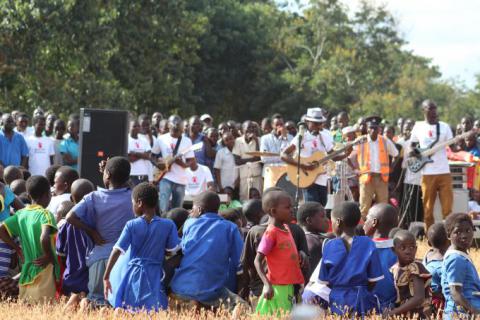NO CHILD Should Be Left Behind. I agree, do you?
Chikondi is an 11-year-old girl who lives in a small and remote village about 400 kilometers south of Malawi’s capital city, Lilongwe. She is the eldest of 5 children. Her parents are struggling small scale farmers who do the best they can to take care of their family.
Chikondi is in Grade 3 and loves everything about mathematics. However, she does not get a chance to learn math as often as she would like.
It is very likely that she could suddenly be tasked with looking after her 9-year-old brother at home while her mother and father take her younger sisters to the nearest hospital, which is 35 kilometers away. Or in another occasion, Chikondi may end up missing school to take care of her sisters who often suffer from diarrhea.
When she does manage to go to school though, Chikondi is often late and hardly makes it in time for math class. She is often late because she walks barefooted for approximately 15 kilometers to school, on top of having to help her mother fetch water from the river each morning.
During the rainy season, she and all the other children in the village have to miss school entirely. Her school only has 2 classrooms for Grade 4 students, the highest grade available, meaning that she along with other pupils have to sit under a tree to learn. At a school that doesn’t go further than Grade 4, it unfortunately also means that in a year or so, Chikondi will not be learning any math at all.
Meanwhile; in the capital city, Lilongwe, over 400 kilometers from Chikondi at the Save the Children’s Malawi Country Office – all the buzz has been about the launch of the Every Last Child campaign that took place on May 26th in Mchinji district. Leading up to the launch, emails had been going back and forth exponentially, and phones ringing at a rate slightly higher than usual.
So what do these too stories have to do with each other? Well simply put, one story causes the other.
The Every Last Child campaign, Save the Children’s new global campaign, is the newest opportunity and tool created to increase dialogue and action towards uplifting the lives of children often excluded or limited from reaching their full potential.
In Malawi, the campaign has been contextualized to specifically advocate for; ‘children living in the remotest areas’, i.e. Children like Chikondi. It is specifically asking for 3 things:
First, by 2018 the Government of Malawi should increase budgets for educational and health infrastructure in remote areas by 30%. Second, that by 2018, Integrated Community Case Management is being implemented in 20 districts across Malawi and 90% of Health Surveillance Assistants (HSAs) operate from their catchment areas. And third, that by 2018, the Government of Malawi has increased budgets for Child Poverty (Child focused social protection) and Child Protection service provision in remote areas by 30%.
Photo Caption: Malawian musical sensation, Lawi & the Mango performing for the crowd at the Every Last Child launch in Mchinji district.
May 26th was a high profile event to kick start this campaign with children from Traditional Authority (T/A) Gumba in Mchinji district presenting a petition to ask for a better life. It was also a platform for Save the Children’s Malawi County Office to tell the nation about the impact it has made so far but most importantly, how this impact can be lessened if children in the remotest areas are continuously left behind.
Personally I envision a future Malawi where no child gets left behind, where fewer adults are illiterate and where less people are living below the poverty line. Do you?
Disclaimer: The story of Chikondi has been used to illustrate hardship faced by many children living in remote areas. It is not based on one real child but a number of children who are facing destitution whilst growing up in remote villages.
Written by Lindiwe Bandazi, Global Health Corps Advocacy Fellow-Health and Nutrition
 Malawi
Malawi 